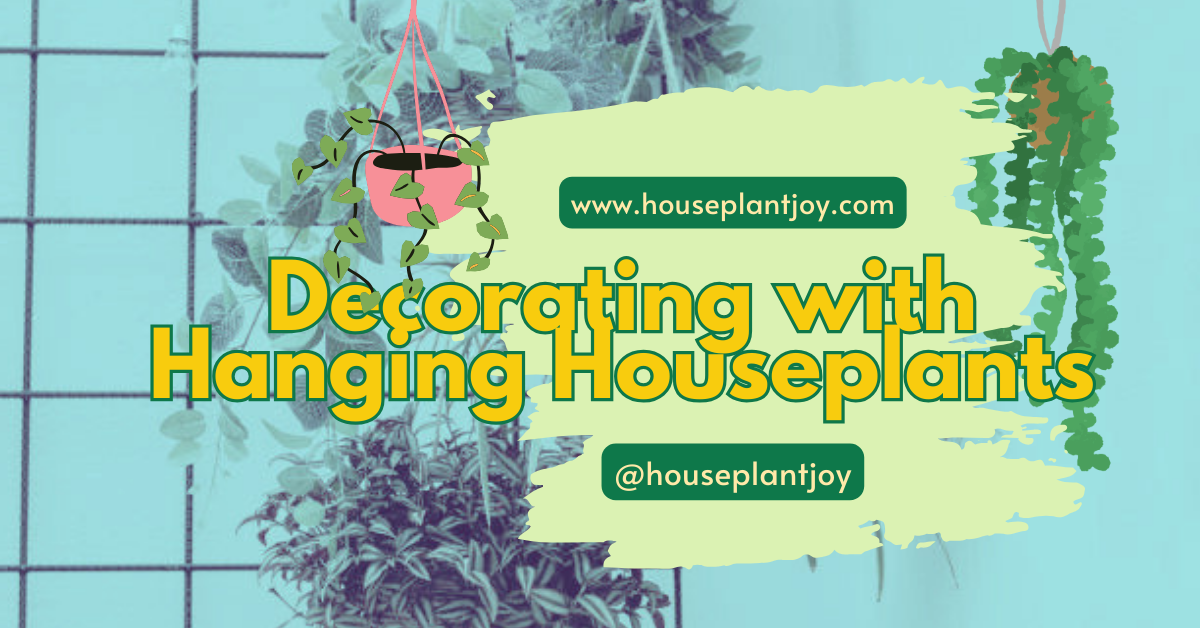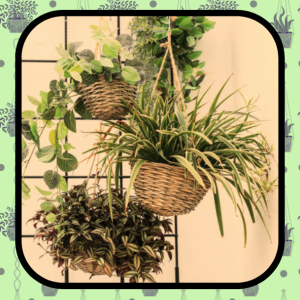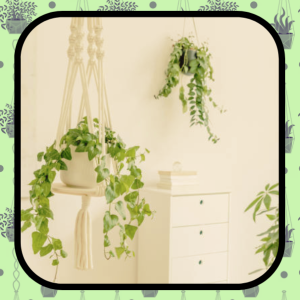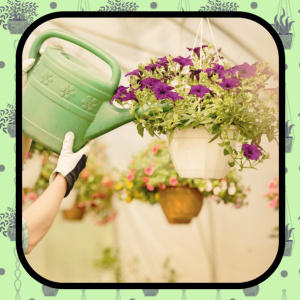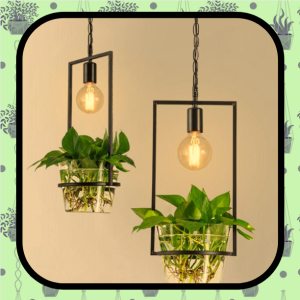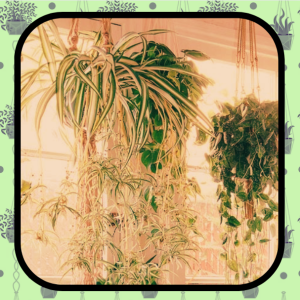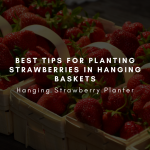HousePlantJoy is supported by our audience. When you purchase through one of our links, we may earn a small affiliate commission. As an Amazon Associate I earn from qualifying purchases. Your cost is not affected.
==================
Decorating with hanging houseplants can transform your space into a vibrant and lush haven. Incorporating greenery at varying levels adds visual interest and enhances your living environment by purifying the air and elevating your mood.
Decorating with Hanging Houseplants: Elevate Your Space with Creative Greenery
Whether strung above a sunny kitchen window or elegantly draping over a bookshelf, there are many creative ways to display your botanical friends. Hanging plants bring a new dimension to interior decor, utilizing vertical space to layer your design and creating intriguing focal points in any room.
When choosing the right plants for your hanging baskets, consider your space’s lighting and humidity conditions to ensure they thrive. The variety of hanging planters available allows for personalization in your decor. This ranges from macramé hangers that add a bohemian touch to sleek and modern ceramic containers that suit a more contemporary aesthetic.
Installing these green accents can be a simple weekend project, turning your home into a refreshing green escape. With carefully selected plants and thoughtfully placed planters, you’re ready to breathe new life into your interior space.
Key Takeaways
- Hanging houseplants liven up spaces by combining greenery with home decor.
- Pick plants and planters that fit your living environment and style for healthy growth and visual harmony.
- Proper installation and maintenance ensure your plants remain a stunning and lasting addition to your home.
Benefits of Hanging Houseplants
Incorporating hanging houseplants in your decor strategy not only elevates the aesthetic appeal of your space but also offers functional advantages like improving air quality and saving valuable floor space.
Aesthetic Enhancement
You can immediately transform the look of your rooms by introducing hanging plants. They add texture and a vibrant splash of color, creating a dynamic visual interest. Notable for their versatility, hanging plants can be stationed at different heights to draw the eye upward and bring a sense of depth and complexity to your indoor environment.
Space Saving
For you dealing with limited square footage, hanging houseplants are a godsend. They utilize vertical space, allowing you to keep surfaces clutter-free. You can hang plants over work areas or in small corners, effectively enhancing your space without sacrificing functionality.
Improved Air Quality
Hanging plants are not just visually pleasing. They serve a crucial role in your home’s environment by purifying the air.
They reduce levels of certain pollutants, such as formaldehyde and benzene, thus contributing to a healthier living space. The presence of these plants can also help regulate humidity levels within a room, promoting a more comfortable atmosphere for you and your family.
Choosing the Right Plants
Selecting the perfect hanging houseplants for your space involves considering pet safety, ease of care, and plant size. These factors ensure a harmonious balance between your home decor and the well-being of your indoor environment.
Pet-Friendly Options
When you have furry friends at home, ensuring their safety is a priority. Opt for spider plants, which are non-toxic and thrive in a variety of lighting conditions.
The 17 Best Indoor Hanging Plants to Capitalize on Vertical Space offers a glimpse into these adaptable plants. As for trailing options, Boston Ferns make a lush, safe choice that pets can coexist with peacefully.
Low Maintenance Varieties
You might prefer plants that require minimal attention. Pothos and Philodendrons are excellent low-maintenance options that can tolerate erratic watering patterns and thrive even in low-light conditions. For more inspiration on hardy plants that are also elegant, explore ideas from 15 Hanging Plants from the Ceiling Ideas To Try.
Plant Size Considerations
Take note of the growth patterns and mature size of the plant. Small spaces benefit from compact plants such as String of Pearls, which add a delicate, decorative touch without overwhelming the area.
Large, voluminous plants like the Bird’s Nest Fern can create an impressive display in more spacious rooms. The curated list from House Beautiful further discusses the aesthetics and space limitations.
Types of Hanging Planters
Hanging planters can elevate your décor by introducing eye-level or higher greenery. They’re ideal for saving floor space while adding a fresh, decorative touch to your home.
Macramé Planters
Macramé planters offer a boho-chic vibe with their intricate, woven designs. They are crafted using various knotting techniques, providing a secure and stylish way to display your plants. Discover clever ways to hang plants using macramé holders that enhance the aesthetic of any room.
Ceramic and Metal Planters
Ceramic and metal planters are durable options that come in an array of colors and finishes, from glossy ceramics for a sleek look to rusted metal for an industrial feel. Their styles range from simple to ornate, while metal planters often provide a modern and clean appearance. Explore these creative hanging planter ideas to find the perfect match for your space.
Self-Watering Planters
Self-watering planters are a convenient choice if you seek functionality and form. These planters ensure your plants receive the right amount of water, even when you’re busy.
They utilize a reservoir to steadily supply water, which is perfect for frequent travelers or those new to plant care. Take a look at quirky hanging indoor planters for self-watering options that are as unique as they are practical.
Placement Ideas
The strategic placement of hanging plants maximizes their aesthetic appeal and benefits your home’s environment. Here’s how to incorporate greenery effectively in specific areas of your home.
Window Areas
Bask in the Light: Hanging plants thrive in the ample sunlight by windows. Install sturdy hooks above your window frame and select plants that prosper in direct or indirect light. Pair hanging plants with geometric wallpaper for a decorative touch, combining natural shapes with eye-catching patterns.
Balconies and Patios
Outdoor Oasis: Turn your balcony or patio into a refreshing retreat. Use overhead beams or railings to hang plants like spider plants or ferns. This functional placement enhances privacy and creates a lush, inviting space for relaxation or entertainment.
Bedroom and Living Areas
Elevate Your Decor: In bedrooms and living areas, hanging plants can segment space and add a calming natural element. Consider using a curtain rod to hang several plants, creating a green curtain and a stunning visual impact. Choose plants that require less light for areas away from windows and ensure they’re easily accessible for care and maintenance.
Installation Tips
When adding hanging houseplants to your home, consider the stability of fixtures, strategic placement for aesthetic appeal, and ensure they remain easily accessible for care and maintenance. Follow these specific tips to achieve the best results.
Securing Fixtures
Choose the Right Hardware: For safety and stability, use anchors, hooks, or brackets that are appropriate for your wall or ceiling material. Typically, masonry requires plastic or lead wall plugs, while drywall might need toggle bolts or wing anchors. Check the weight capacity of the hardware to ensure it can support your plants.
Installation Height: Secure fixtures at a height that enhances the plant’s visibility while ensuring it doesn’t interfere with movement in the room.
Plant Arrangement
Grouping by Needs: Arrange plants with similar sunlight and watering requirements together. This makes it easier to care for them and ensures each plant thrives.
Visually Pleasing Patterns: Create a dynamic display by hanging plants at different heights or in asymmetrical patterns to add depth to your space. Consider the overall aesthetic and choose hanging planters that complement the style of the room.
Maintaining Accessibility
Ease of Reach: Place hanging plants in locations where they can be easily taken down for watering, pruning, and other care practices. Avoid spots that are too high or require awkward positioning to access.
Routine Care Schedule: Set a regular care schedule to check plant health, which includes inspecting for pests, dusting leaves, and assessing soil moisture. Remember that consistent attention can prevent issues from becoming severe.
By following these tips, your hanging plants will look beautiful and stay healthy and be a joy to maintain.
Watering and Care
Proper watering and care are essential to the health and growth of your hanging houseplants. Understanding the unique requirements of your plants will ensure they thrive and remain vibrant throughout the year.
Watering Techniques
For your hanging plants, implementing a consistent watering schedule is key. Most hanging plants prefer their soil to be kept evenly moist.
It’s vital to check the top inch of soil. If it feels dry, it’s time to water. To avoid mess and water spillage, use a long-spout water can or consider a drip-watering system for hard-to-reach plants.
Some hanging plants, such as the Prayer Plant, may exhibit unique behaviors like leaves folding up at night, which can help you determine their watering needs.
Pruning and Maintenance
Regular pruning helps maintain the shape of your plants and encourages healthy growth. Remove any yellow or dead leaves and trim back overgrown vines to keep your plant full and lush.
For some plants, such as trailing varieties, pruning can stimulate more foliage production. Clean cuts with sharp scissors or pruners are recommended to avoid damage to the stems.
Seasonal Adjustments
Be aware of the changes in your plants’ needs as seasons change. During the warmer months, hanging plants may require more frequent watering due to increased evaporation.
Conversely, water is less frequent in the cooler months as the growth slows down and lower temperatures reduce the soil’s drying rate. Seasonal light changes also play a role; ensure your hanging plants receive adequate light, whether through a sunny window or supplemental lighting.
Design Themes
When you bring plant life into your home, you can create a space that reflects your personality and design preference. Here’s how to incorporate hanging houseplants into various design themes that can transform your home’s aesthetic.
Bohemian Vibe
Mix and match different textures and patterns with your hanging planters in a Bohemian-style space. Utilize materials like macrame, rattan, and ceramic to add depth.
Plants like Pothos and Spider Plants, with their cascading leaves, contribute to a relaxed, free-spirited ambiance. For inspiration, explore ideas on how to display your houseplants to enhance the boho feel.
Minimalist Approach
If you prefer a Minimalist design, focus on simplicity and function. Choose sleek, geometric planters and make use of a monochromatic color scheme.
Consider incorporating single large-leaf plants like Monstera or Bird of Paradise for a statement piece. Check out these clever ways to hang plants while keeping the minimalist aesthetic intact.
Tropical Atmosphere
Creating a Tropical theme requires lush, vibrant plants that transform your space into a green haven. Opt for hanging planters that allow ample room for growth and choose species like Ferns and Philodendron for that dense foliage look. Tips on how to style houseplants can guide you in achieving that tropical paradise vibe in your home.
Lighting Considerations
Understanding their lighting needs is crucial when incorporating hanging houseplants into your decor. Whether you’re leveraging natural sunlight or exploring artificial lighting options, the health and growth of your plants are at stake.
Natural Light Requirements
Most hanging plants thrive under certain natural light conditions. It’s important to assess your windows’ direction and the sunlight’s intensity penetrating your space. Like the trailing effect of certain species, plants require direct sunlight, often found in south-facing windows, while others prefer the softer, diffused light from an east-facing window.
- Direct Sunlight:
- South-facing windows
- Ideal for plants such as succulents
- May require curtain adjustments to prevent scorching
- Indirect Sunlight:
- East/West-facing windows
- Suitable for ferns and ivies
- Provides balanced light without direct exposure
Artificial Lighting Options
Artificial lighting can simulate the sun’s effects if your space lacks adequate natural light. Choose the right spectrum of light. Full-spectrum bulbs closest mimic natural sunlight and are optimal for photosynthesis.
- LED Grow Lights: Efficient, long-lasting, and available in different spectrums. Hang them above the plants for a consistent light source.
- Fluorescent Light Fixtures: Cost-effective and widely available. Ideal for seedlings and low-light plants.
Selecting proper lighting ensures your hanging plants remain vibrant and contribute to the intended aesthetic of your home. Use artificial lights to supplement during darker months or strategically place plants in your home based on natural light availability.
Troubleshooting Common Issues
When decorating with hanging houseplants, encountering a few hiccups is quite common. Here’s how you can address overwatering, pests, and growth concerns to keep your greenery flourishing.
Overwatering Signs
You might be overwatering if your plant’s leaves are yellowing or the soil is consistently damp. Root rot is a severe consequence, often indicated by a musty smell. Always check the soil is partially dry before watering again, and ensure your hanging planters have adequate drainage.
Pest Prevention
To prevent pests, maintain a regular inspection routine for signs like discoloration or sticky residue on leaves. Early on, introduce natural deterrents, such as neem oil or insecticidal soap. Keeping your plants healthy and stress-free also makes them less susceptible to infestations.
Growth Problems
If your plant is getting leggy or its leaves are pale, it’s likely craving more light. Relocate it closer to natural light sources or consider using LED grow lights. On the other hand, if the growth is stunted or the leaves scorch, it could be receiving too much direct sunlight and may need a spot with more shade.
Video Credit: @HarliG
Wrapping It Up
Hanging houseplants are a great way to add life to any room. Choose plants that fit your light conditions. Think about the height and style of planters.
They can transform a space into a green, cozy area. Remember to water them regularly. Enjoy your new, lively decor!
Frequently Asked Questions
How do I securely hang plants from the ceiling without drilling?
To hang plants without drilling, consider adhesive hooks rated for the weight of your plant or use tension rods positioned securely between walls.
What are some creative ideas for hanging plants on walls indoors?
Innovative wall-mounted planters can transform your indoor garden. Magnetic planters or vertical plant walls are unique methods that subtly integrate greenery into your decor. For inspiration, explore various creative hanging houseplant ideas.
Can you suggest some ways to feature hanging plants in a bedroom setting for added decor?
Cascading plants over a headboard or a minimalist hanging shelf with small potted plants can create a tranquil atmosphere for the bedroom. Opt for low-light-friendly species to suit the environment.
What alternatives to live plants can I put in my indoor hanging planters for decoration?
Silk plants or high-quality faux greenery offer a maintenance-free alternative to live plants, allowing for lush aesthetics without the need for light or water.
How can I hang plants in front of windows to enhance both indoor and outdoor aesthetics?
Use a curtain rod to suspend plants, ensuring they are suitable for sunlight exposure. This can create a beautiful view from both inside and out.
Are there any trending styles for incorporating hanging plants into home decor?
Current trends for hanging plants include bohemian macrame hangers, geometric terrariums, and groupings of hanging planters at varying heights to add dimension to any room.
Learn More About Houseplants!
Discover more types of houseplants, their benefits, and how to care for them with us! Join us on Facebook, Instagram, and Twitter for beautiful photos, plant care tips, and a community that celebrates the joy of indoor gardening.
Facebook: https://www.facebook.com/houseplantjoyblog
Instagram: http://instagram.com/houseplantjoy20
Twitter: https://twitter.com/HouseplantJoy
Let’s nurture our green spaces together!

